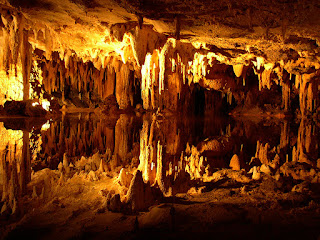Augmenting Reality in the Classroom
"I thought that the field trip was amazing because as I ascended to the the cave, I heard faint noises coming from the birds in the Garden of Eden. I looked at the fresh water streaming and the aroma that filled the air was a mixture between humid air and water, which made my face scrunch up in disgust. Then suddenly, I heard a clear voice that started up like this. "Bong Um Duck Dim Sum Ma." The voice soon lead me into a forest, also known as the Garden of Eden. I walked, and tried to observe the crack on the rock. It somehow reminded me of a fault. As I reached this collapsed ceiling of Son Doong, I saw a bright ray of sunshine into the cave. I often wondered, if it were possible for vegetation in caves, and I found my answer. Yes. The jungle that was connected to the cave, making the cave available for vegetation. The vast air that blew against on my shoulder gave me a chill behind my spine."
The above was a piece of writing one of my students did as a writing warm up last month. We were learning about water distribution on earth, and how karst formations are created through weathering and erosion. I thought it would be fun to visit a limestone cave and have kids write about it by using some of the connections to descriptive writing they had learned in language arts class.
We didn't go to an actual cave however, but visited one virtually. The Son Doong cave in Vietnam was recently discovered and National Geographic explored and mapped it out for an immersive experience complete with HD imagery, sounds, location map and interpretive signs along the way. With a little imagination, it was not hard for my students to imagine how the cave smelled, and how their appearance changed from clean cut to muddy and wet as they ventured in.
What is AR?
Such is the power of AR, or Augmented Reality. The SAMR model of educational technology highlights that reading interactive features and being able to zoom in and focus on details fall under "Redefinition" and "Modification".
360 Degree Videos
Simply do a youtube search for 360 degree video on youtube and you'll find a growing number of videos which have a user toggle in the corner allowing the viewer to turn in any direction and focus on subjects in the video which are interesting to them. See this one below I used with cardboard below for a lesson as we are learning about galaxies and scale of bodies in the solar system:
Cardboard
Our tech integrationist had ordered some cardboard and I wanted a means for students to understand properties of scale in our Earth and Space unit and give them an interactive ability when "travelling through through space". Taking the above video, small groups searched for the video on their phones and hit the cardboard icon which was then viewed through cardboard. Most said it was the coolest thing that they had done in school all week! *One note, cardboard only works with Android, but Iphone users can install the app "in360tube" to use.
Google Street View
Google street view gives you the opportunity to see what a place looks like in a 360 degree photosphere. One of my favorite Chrome web apps is Earth View from Google Earth which shows a different Google earth view every time you hit a new tab on your browser. A click on the map below takes you to street view to travel, view pictures or photospheres.
The above was a piece of writing one of my students did as a writing warm up last month. We were learning about water distribution on earth, and how karst formations are created through weathering and erosion. I thought it would be fun to visit a limestone cave and have kids write about it by using some of the connections to descriptive writing they had learned in language arts class.
 |
| Image courtesy of CC |
What is AR?
Such is the power of AR, or Augmented Reality. The SAMR model of educational technology highlights that reading interactive features and being able to zoom in and focus on details fall under "Redefinition" and "Modification".
360 Degree Videos
Simply do a youtube search for 360 degree video on youtube and you'll find a growing number of videos which have a user toggle in the corner allowing the viewer to turn in any direction and focus on subjects in the video which are interesting to them. See this one below I used with cardboard below for a lesson as we are learning about galaxies and scale of bodies in the solar system:
Cardboard
Our tech integrationist had ordered some cardboard and I wanted a means for students to understand properties of scale in our Earth and Space unit and give them an interactive ability when "travelling through through space". Taking the above video, small groups searched for the video on their phones and hit the cardboard icon which was then viewed through cardboard. Most said it was the coolest thing that they had done in school all week! *One note, cardboard only works with Android, but Iphone users can install the app "in360tube" to use.
 |
| Students take a break from model building to travel through space using 360 videos and cardboard. |
Google Street View
Google street view gives you the opportunity to see what a place looks like in a 360 degree photosphere. One of my favorite Chrome web apps is Earth View from Google Earth which shows a different Google earth view every time you hit a new tab on your browser. A click on the map below takes you to street view to travel, view pictures or photospheres.


Comments
Post a Comment